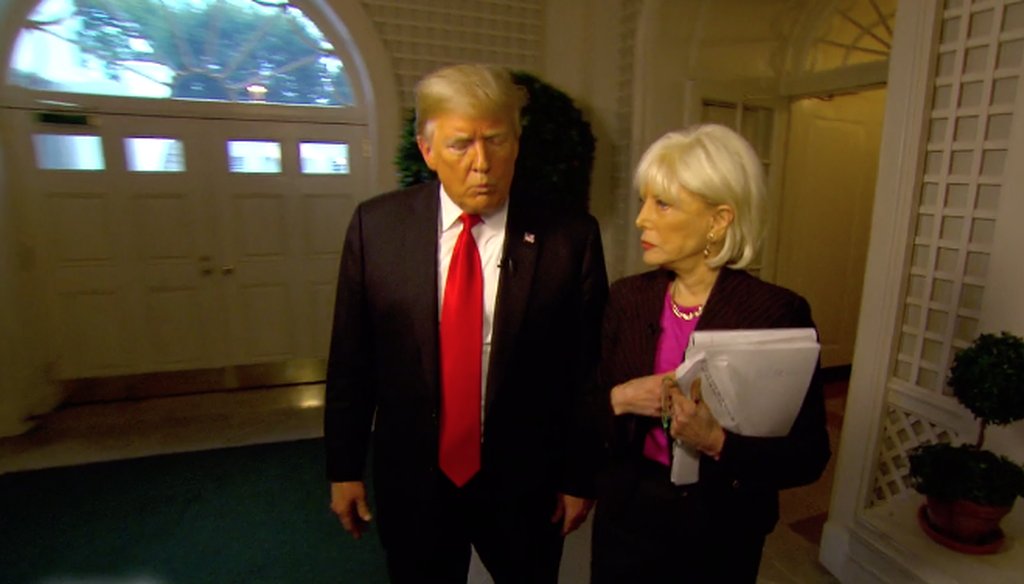Stand up for the facts!
Our only agenda is to publish the truth so you can be an informed participant in democracy.
We need your help.
I would like to contribute

President Donald Trump and CBS correspondent Lesley Stahl at the White House for an interview that aired on "60 Minutes."
In an interview on CBS’ 60 Minutes, President Donald Trump addressed a wide range of topics, from his comments about Christine Blasey Ford, who accused Supreme Court nominee of past sexual assault, to his opinion of whether Russia’s Vladimir Putin is involved in assassinations.
Here’s a rundown of some of the assertions Trump made during the Oct. 14, 2018, interview with Lesley Stahl.
Stahl: "Do you still think that climate change is a hoax?"
Trump: "I think something's happening. Something's changing and it'll change back again. I don't think it's a hoax, I think there's probably a difference. But I don't know that it's man-made."
For the record, we rated the claim that climate change is a "hoax" Pants on Fire. But these comments represent a break from some of Trump’s prior statements.
On Nov. 6, 2012, Trump tweeted, "The concept of global warming was created by and for the Chinese in order to make U.S. manufacturing non-competitive."
Trump later portrayed his effort to blame China as an attempt at a joke. However, he had a record of using the word "hoax" on other occasions to describe climate change.
For instance, on Dec. 30, 2015, Trump told the crowd at a rally in Hilton Head, S.C., "Obama's talking about all of this with the global warming and … a lot of it's a hoax. It's a hoax. I mean, it's a money-making industry, okay? It's a hoax, a lot of it."
North Korea’s Kim Jong Un "understands denuclearization and he's agreed to it."
This isn’t entirely correct.
For starters, Trump technically signed a joint communique with Kim in Singapore, not an agreement. It was a statement of broad goals, not a binding promise to deliver on them.
One of the points in the joint communique was that North Korea "commits to work towards complete denuclearization of the Korean Peninsula."
North Korea has said that before, and Korean Peninsula experts say that what North Korea means by denuclearization probably isn’t what the United States has in mind.
"When the North Koreans say complete denuclearization, they mean the removal of the threat of nuclear war by both North Korea and the United States," said Joseph DeThomas at the Penn State School of International Affairs. "This means the removal of nuclear capable systems such as aircraft, ships and submarines from the Korean Peninsula and the area around it, as well as the eventual removal of North Korean nuclear weapons at a time North Korea feels safe. They have sometimes included an end to the U.S. nuclear guarantee to South Korea or the end of the U.S.-ROK alliance."
Republicans and conservatives pushed back on Trump’s earlier assertion that North Korea was no longer a threat. The conservative Heritage Foundation’s Bruce Klingner, for one, called the joint statement "very disappointing."
"The Singapore Communique did not bring about any changes to North Korean nuclear capabilities," Klingner told us. "In fact, the nuclear provision was weaker than that contained in the September 2005 Six Party Talks Joint Statement."
"I told President Xi we cannot continue to have China take $500 billion a year out of the United States in the form of trade and others things."
This number is off-base. (And he’s been using the talking point at least as far back as 2015.)
In 2017, the value of Chinese goods imported to the United States ($505 billion) exceeded American goods exports to China ($130 billion) by roughly $375 billion. When you factor in services, the United States ran a roughly $336 billion deficit with China last year — which means Trump’s figure was off by about $164 billion.
We should note that it’s questionable to say that a trade deficit amounts to taking money "out of the United States."
Trade deficits stem from demand among U.S. consumers for products that U.S. producers cannot meet, whether that’s because no American company makes the product in question, because American companies aren’t making the product cheaply enough, or because U.S.-produced wares simply aren’t appealing enough to consumers.
"We should be running deficits with some countries and surpluses with others, since comparative advantage will vary, country by country," I.M. (Mac) Destler, who teaches at the University of Maryland School of Public Policy, has told us previously.
"The European Union was formed in order to take advantage of us on trade."
According to the European Union itself, the E.U. "was set up with the aim of ending the frequent and bloody wars between neighbors, which culminated in the Second World War." It began in 1950 with the European Coal and Steel Community -- an effort "to unite European countries economically and politically in order to secure lasting peace."
"We shouldn't be paying almost the entire cost of NATO to protect Europe."
This exaggerates the scale of the burden on the United States.
The United States pays for 22 percent of NATO's common fund. Beyond that relatively small amount, the cost of NATO is undefined.
The organization does total the defense budgets of its members, and based on that, U.S. defense spending equals about 70 percent. But the United States spends as much as it does because it is a global military power, which by and large, the European members are not. It is an apples and oranges comparison.
"I'm the one that gave Ukraine offensive weapons and tank killers. Obama didn't."
Trump has a point here.
Trump’s rhetoric has consistently indicated warmth and trust toward Russia and Putin, but despite his rhetoric, tough U.S. policy aimed at Russia has chugged forward in important ways since Trump became president.
One of these was the Trump administration’s approval of lethal arms sales to Ukraine. In this regard, Trump’s policy went further than Obama’s did.
To the extent that Trump’s policies against Russia have met or exceeded Obama’s post-2014 policies, the credit goes more to his agencies and Congress, experts said. These policies are ones that "hawkish military types in his orbit like, and were not likely from his own initiative," Susanne Wengle, University of Notre Dame political scientist told PolitiFact in February.
"Do you really think I'd call Russia to help me with an election? Give me a break. They wouldn't be able to help me at all. Call Russia. It's so ridiculous."
Special Counsel Robert Mueller continues to investigate the broad question of whether the Trump campaign improperly collaborated with Russia during the 2016 campaign, but Trump did quite publicly "call Russia to help me with an election."
In a press conference at Trump National Doral golf course July 27, Trump referred to emails belonging to his opponent, Hillary Clinton. Trump said, "Russia, if you’re listening, I hope you’re able to find the 30,000 emails that are missing. I think you will probably be rewarded mightily by our press."
Trump later said he was being sarcastic.
"My poll numbers are very good."
Actually, his approval rating is toward the bottom of the list of post-World War II presidents, according to Gallup. Here are their ratings at the equivalent time in their presidency -- about 625 days into their tenure:
George W. Bush: 67 percent
Dwight Eisenhower: 66 percent
George H.W. Bush: 66 percent
Lyndon B. Johnson: 65 percent
John F. Kennedy: 63 percent
Richard Nixon: 58 percent
Gerald Ford: 48 percent
Jimmy Carter: 48 percent
Barack Obama: 46 percent
Donald Trump: 43 percent
Ronald Reagan: 42 percent
Bill Clinton: 42 percent
Harry Truman: 35 percent
Stahl: "What about the forced separation of children?"
Trump: "That was the same as the Obama law. You know, Obama had the same thing."
This is False.
There was no Obama law mandating family separations. And Obama’s administration did not separate families arriving at the border the same way the Trump administration has done so. Family separations under Obama’s watch were relatively rare and nowhere near the rate that occurred as a result of Trump’s "zero-tolerance" immigration policy.
Jeh Johnson, Obama’s Homeland Security secretary from 2013 to the end of his presidency, told NPR in June that separations may have happened in "some exigent situation" but not as a matter of practice or policy.
In contrast, family separations under Trump happened as a consequence of a policy to prosecute all immigrants who came into the United States illegally, even when they came in with their children. More than 2,300 children were separated from their parents as a result of the Trump policy. The Department of Homeland Security said the Obama administration did not count the number of families separated at the border.
"There has been no administration in the history of our country, and I say this openly and proudly, that in its first two years" accomplished more.
This is questionable.
We turned, as we have in the past, to long-running data on legislation collected by govtrack.us and its founder, Joshua Tauberer. One caveat: The data only looks at legislation, not other activity, such as executive-branch regulatory decisions, so it does not give a comprehensive picture of what his administration has done.
As of the time of the 60 Minutes interview, according to the data, Trump had signed into law the second-smallest number of bills compared to any president going back to Dwight Eisenhower.
However, since bills have been getting larger over time, counting pages can be a better measure of how much each president has signed. By this measure, Trump has fared better, signing into law more pages than any president except Barack Obama and Bill Clinton. (Presidents Harry Truman, Lyndon B. Johnson, and Gerald Ford aren’t included in the comparison because they started their tenure in the middle of a congressional session, which would have created an unfair comparison.) Here’s the full breakdown, in descending order by number of pages.
President
Number of bills
Number of pages
Barack Obama
279
6,394
Bill Clinton
370
6,088
Donald Trump
265
6,032
Dwight Eisenhower
1,782
4,677
George W. Bush
244
3,987
George H.W. Bush
426
3,429
Ronald Reagan
352
3,234
Jimmy Carter
522
2,976
John F. Kennedy
1,431
2,939
Richard Nixon
615
2,255
Trump has signed a major tax bill as well as legislation on veterans health care and human trafficking; he is poised to sign a bill soon that addresses opioid addiction.
That said, he has so far failed to achieve other major campaign priorities, including a full repeal of the Affordable Care Act, an infrastructure bill, or new elements of a wall on the border with Mexico.
Our Sources
Sources linked in article












































